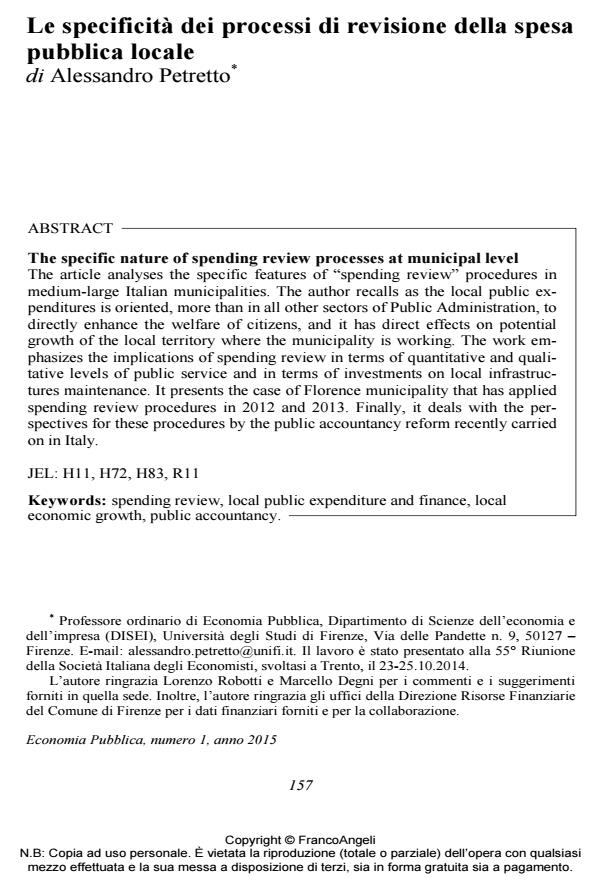The specific nature of spending review processes at municipal level
Journal title ECONOMIA PUBBLICA
Author/s Alessandro Petretto
Publishing Year 2015 Issue 2015/1 Language Italian
Pages 19 P. 157-175 File size 198 KB
DOI 10.3280/EP2015-001007
DOI is like a bar code for intellectual property: to have more infomation
click here
Below, you can see the article first page
If you want to buy this article in PDF format, you can do it, following the instructions to buy download credits

FrancoAngeli is member of Publishers International Linking Association, Inc (PILA), a not-for-profit association which run the CrossRef service enabling links to and from online scholarly content.
The article analyses the specific features of "spending review" procedures in medium-large Italian municipalities. The author recalls as the local public expenditures is oriented, more than in all other sectors of Public Administration, to directly enhance the welfare of citizens, and it has direct effects on potential growth of the local territory where the municipality is working. The work emphasizes the implications of spending review in terms of quantitative and qualitative levels of public service and in terms of investments on local infrastructures maintenance. It presents the case of Florence municipality that has applied spending review procedures in 2012 and 2013. Finally, it deals with the perspectives for these procedures by the public accountancy reform recently carried on in Italy.
Keywords: Spending review, local public expenditure and finance, local economic growth, public accountancy
Jel codes: H11, H72, H83, R11
- Baskaran T., Feld L.P., Schnellenbach J. (2014). Fiscal Federalism, Decentralization and Economic Growth: Survey and Meta-Analysis. CESifo Working Paper No. 4985, September.
- Benassy-Quéré A., Coeuré B., Jacquet P., Pisani-Ferry J. (2014). Politica Economica, teoria e pratica, ed. italiana a cura di A. Petretto e F.F. Russo. Bologna: il Mulino.
- Besley T. (2007). The New Political Economy. Economic Journal, 117: 540-557. DOI: 10.1111/j.1468-0297.2007.02097
- Blanchard O., Leigh D. (2013). Growth Forecast Errors and Fiscal Multipliers, IMF Working Paper 13/1, Research Department, January.
- Commissione Europea (2014), Italy-Review of progress on policy measures relevant for the correction of macroeconomic imbalances, November.
- Cottarelli C.(2014). Proposte per una revisione della spesa pubblica per gli anni 2014-2016. Ministero dell’Economia e della Finanza.
- Cottarelli C., Jaramillo L. (2013). Walking Hand in Hand: Fiscal Policy and Growth in Advanced Economies. Review of Economics and Institutions, 4: 1-25.
- De Ioanna P., Degni M. (2014). L’orologiaio e il tagliaboschi, paper presentato alla 55° Riunione della Società Italiana degli Economisti, Trento 23-25.10.2104.
- Dixit A. (2002). Incentives and Organizations in the Public Sector: an Interpretative Review. The Journal of Human Resources, 34: 696-727.
- Dixit A. (2010). Democracy, Autocracy and Bureaucracy. Journal of Globalization and Development, 1: 1-45. DOI: 10.2202/1948-1837.1010
- Giarda D.P. (2011). Dinamica, struttura e criteri di governo della spesa pubblica: un rapporto preliminare. Quaderni dell’istituto di economia e finanza. Milano:
- Università Cattolica del Sacro Cuore. Giarda D.P. (2012). Elementi per una revisione della spesa pubblica, http://leg16camera.it/temiap/temi16/Revisione_spesa.
- Hebous S., Zimmerman T. (2014). Revisiting the Narrative Approach of Estimating Tax multipliers, CESifo Working Paper, n. 5040, October.
- IFEL (2014). L’armonizzazione dei sistemi contabili, verso l’attuazione della riforma. Roma: IFEL, Dipartimento Finanza Locale, Dossier e Manuali, www.fondazioneifel.it.
- International Monetary Fund (2010). Will it hurt? Macroeconomic, effects of fiscal consolidations, Ch. 3, The World Economic Outlook, October.
- Magazzino C. (2013). Alcune linee guida per una spending review. In: Magazzino C., Romagnoli G.C. (a cura di). La legge di stabilità e politica economica in Italia. Milano: FrancoAngeli.
- Monacelli D., Pennisi A. (2011). L’esperienza della spending review in Italia: problemi aperti e sfide per il futuro. Politica economica, 27: 255-290. DOI: 10.1429/35200
- Perotti R. (2011). The “austerity myth”: gain without pain?, W.P. 17571
- Perotti R. (2012). The Effects of Tax Shocks on Output: Not So Large, But Not Small Either. American Economic Journal: Economic Policy, 4: 214-237. DOI: 10.3386/w16786
- Petretto A. (2014). Finanza pubblica territoriale, economia locale e crescita. In: Cappellin R., Marelli E., Rullani E., Sterlacchini A. (a cura di). Crescita, investimenti e territorio: il ruolo delle politiche industriali e regionali. Website “Scienze regionali”, www.rivistasr.it, ebook 2014.1.
- Romer C.D., Romer D. (2010). The Macroeconomic Effects of Tax Changes: Estimates Based on a New Measure of Fiscal Shocks. American Economic Review, 100: 763-801. DOI: 10.3386/w13264
- Virno C. (2013). L’anello debole della nuova revisione della spesa, www.lavoce.info, 22.11.2103.
Alessandro Petretto, Le specificità dei processi di revisione della spesa pubblica locale in "ECONOMIA PUBBLICA " 1/2015, pp 157-175, DOI: 10.3280/EP2015-001007